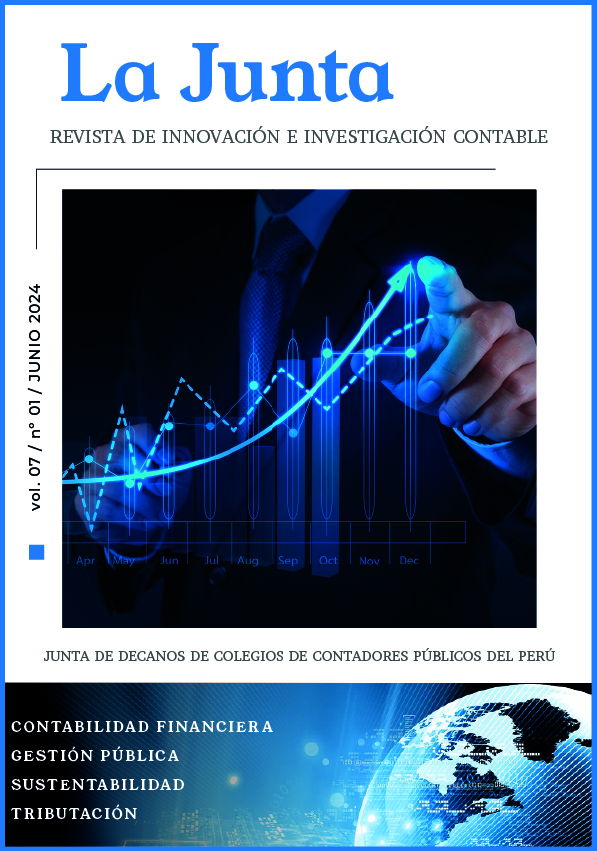Fiscal and environmental impact of the integrated use of oil palm (Elaeis guineensis) in timber production in the Amazon
DOI:
https://doi.org/10.53641/junta.v7i1.130Keywords:
Direct and indirect taxes, Special Tax Credits of the General Sales Tax, Reduced Income Tax rates, tax exemptions and incentives, environmental liabilitiesAbstract
The objective is to analyze the fiscal and environmental impact of the comprehensive use of oil palm (Elaeis guineensis) in wood production in the Amazon; The expansion generates a significant environmental impact, including deforestation, loss of biodiversity and the emission of greenhouse gases; Additionally, the traditional wood industry faces the challenge of finding sustainable raw materials; The use of oil palm stipes (trunks) reduces impacts and promotes the circular economy in the Amazon timber industry.
The methodology is basic, applied, numerical data analysis approach, using techniques and instruments to contrast the hypothesis and obtain results of the fiscal and environmental impact of the use of oil palm stipes in wood.
The results indicate that, from the test applied to 159 employees, a Cronbach's alpha coefficient was obtained for the instrument "Fiscal and environmental impact" of α = 0.904. Therefore, it is highly reliable and for the instrument “Comprehensive use of Elaeis guineensis oil palm in wood production” α = 0.918, high reliability; It is concluded that there is a fiscal and environmental impact of the comprehensive use of Elaeis guineensis (Oil palm) in the production of wood to avoid environmental liabilities.
Downloads
References
Angel, J. (2022). Los impactos de la palma aceitera en Ecuador: un análisis geográfico y multitemporal de la expansión del cultivo y sus relaciones con el sistema socioecológico de la provincia de Esmeraldas. [Tesis de maestría, Universidad Andina Simón Bolívar] Repositorio Institucional CAN.
Angelsen, A., Borner & J., Nepstad. (2023). The impact of oil palm expansion on deforestation and carbon emissions in the Amazon. Environmental Research Letters.
Arévalo, J., & Torres, L. (2022). Incentivos fiscales y beneficios económicos del aprovechamiento de estípites de palma aceitera en la Amazonía peruana. Revista de Política Ambiental y Desarrollo Sostenible, 16(2), 72-89.
Baas, P., & Ramseur, J. (2013). Life cycle assessment of palm oil production: A critical review. Renewable and Sustainable Energy Reviews, 23, 471-489.
Bernal, C. (2010). Metodología de la Investigación. Pearson.
Broschat, T. (2013). Palm Morphology and Anatomy. En U. F. Environmental Horticulture Department, (Ed.) The Institute of Food and Agricultural Sciences (IFAS) is an Equal Opportunity Institution authorized to provide research, 1- 4.
Butler, R. (2012). La palma aceitera y la deforestación: ¿cuál es la relación? CIFOR. Cáccamo, M. (2017). La ética ambiental en América Latina: desafíos y perspectivas. Polis, Revista Latinoamericana, (46), 145-164.
Castree, N. (2014). The hydrosocial cycle and its implications for environmental research. Environment and Planning A, 46(1), 195-210.
Dwianto, W., Darmawan, T., Fitria, & Pramasar, D. (2014). The 6th international symposium of indonesian wood research society. (C. S. Center, Ed.) Research Center for Biomaterials, Indonesian Institute of Sciences, 33 - 40.
Ebadi, S., Ashaari, Z., Late Masoumi, H., Soltani, M., Naji, H., & Vaysi, R. (2019). Evaluation of bending strength of hydrothermally treated oil palm wood in various buffered media using response surface methodology. Journal of Tropical Forest Science, 31(2), 151 - 161.
Fathi, L., Fruehwald, K., & Fruehwald, A. (2014). The potential use of timber from palm trees for building purposes. In Proceedings of the World Conference on Timber Engineering 2014, August 2014, Quebec, Canada (pp. 1–7).
Gutiérrez, M. (2020). El cultivo de palma aceitera y su impacto en el desarrollo local y regional. Revista de Economía Rural, 11(3), 95-112.
Harun, J., & Yueh Feng, L. (2014). Oil palm trunk: 18 million logs and let’s use. Malaysian Timber Industry Board, 27.
Hernández Sampieri, R., Fernández Collado, C., & Baptista Lucio, P. (2014). Metodología de la investigación. McGraw-Hill.
Hoong, Y., Loh, Y., Hafizah, A., Paridah, M., & Jalaluddin, H. (2011). Development of a new pilot scale production of high-grade oil palm plywood: Effect of pressing pressure. Materials and Design, 36, 215 - 219.
Ibrahim, A., Salim, N., Roslan, R., Hashim, R., & Jusoh, M. (2018, 12 de noviembre). Properties of Microwave Modified Oil Palm Trunk Lumber. [Conferencia]. AIP Conference Proceedings 2030, 020216 (2018), 2 - 8.
Jayaraman, P. (2017). Oil Palm Trunks Can Be an Alternative To Rubberwood. The Malaysian Reserve.
Laurence, W., Sayer, J., Cassman, K. (2022). Oil palm and the future of the Amazon. Nature, 597(7876), 341-345.
Ley 27037 de 2011.Ley de Promoción de la Inversión en la Amazonía. 09 de julio de 2011. Congreso de la República.
Lee, S., Hashim, R., & Sulaiman, O. (2013). Viabilidad técnica y económica de la producción de tableros de partículas a partir del estípite de palma aceitera. Journal of Tropical Forest Science, 25(4), 447-454.
Moreno, A. (2018). Plan de negocios para la creación de una empresa fabricante y comercializadora de Briquetas ambientalmente sostenibles. [Tesis de licenciatura, Corporación Universitaria Madre de Dios]. Repositorio institucional UNIMINUTO
Ortiz, A., Pérez, J. y Rodríguez, M. (2021). Uso de estípites de palma aceitera como material de construcción sostenible: Impacto ambiental y económico. Revista de Ingeniería Sostenible, 8(2), 25-42.
Panduro, G., Salinas, N., Cotrina, J., Arbaiza, A., Plaza, J., & Iannacone, J. (2018). Characteristics of oil palm trunks for rearing of Rhynchophorus palmarum (Coleoptera: Curculionidae) in the Peruvian Amazon. Revista Chapingo Serie Ciencias Forestales y del Ambiente, 24(3), 405-414.
Pérez, A., & García, M. (2021). Uso de estípites de palma aceitera como material de construcción sostenible: Evaluación ambiental y económica. Revista de Ingeniería Ambiental, 9(1), 28-45.
Rahman, N., Nordin,K. , Saptri, M. & Jamaludin, M. (2013). (2013, 7- 9 de abril). The Effect of Microwave Treatment on Physical Properties of Oil Palm Trunk (Elaeis guineensis). [Conferencia]. 2013 IEEE Business Engineering and Industrial Applications Colloquium (BEIAC).
Ramírez, P., & Sánchez, L. (2022). Beneficios fiscales y ambientales del aprovechamiento de estípites de palma aceitera en la Amazonía ecuatoriana. Revista de Política Ambiental, 14(1), 68-86.
Rodríguez, P., & Sánchez, M. (2020). El cultivo de palma aceitera y su impacto en el desarrollo socioeconómico de las comunidades amazónicas. Revista de Economía Rural y Agrícola, 12(2), 108-127.
RSPO, WWF & Oxfan. (2021). The environmental and social impacts of oil palm cultivation: A global review. Global Environmental Change, 68, 102270.
Salim, N., Hashim, R., Sulaiman, O., Ibrahim, M., Nasir, M., Sato, M. & Hiziroglu,
S. (September de 2016). Improved performance of compressed oil palm trunk prepared from modified pre-steaming technique. (1. M.-8. Forestry and Forest Products Research Institute, Ed.) Journal of the Indian Academy of Wood Science, 13(1), 1 - 7.
Salim, N., Hashim, R., Sulaiman, O., Ibrahim, M., Sato, M., & Hiziroglu, S. (2011). Optimum manufacturing parameters for compressed lumber from oil palm (Elaeis guineensis) trunks: Respond surface approach. Composites: Part B Engineering, 43(3), 988 - 996.
Samsi, H., Salleh, A., & Jalaludin, Z. (2004). Minimizing the environmental burden of oil palm trunk residues through the development of laminated veneer lumber products. Management of Environmental Quality: An International Journal, 484 - 490.
Srivaro, S., Matan, N., & Lam, F. (2019). Performance of cross laminated timber made of oil palm trunk waste for building construction: a pilot study. European Journal of Wood and Wood Products, 13.
Sulaiman, O., Salim, N., Nordin, N., Hashim, R., Ibrahim, M., & Sato, M. (2012). The potential of oil palm trunk biomass as an alternative source for compressed wood. BioResources, 7(2).
Thanate, R., Tanong, C. & Sittipon, K. (2006). An investigation on the mechanical properties of palm oil trees for the furniture industry. Journal of oil palm research, 114-121.
Vargas, A. (2014). La política fiscal en América Latina: desafíos y perspectivas. Revista CEPAL, (112), 131-151.
Welling, J., & Liese, W. (2019). Wood, Bamboo and Palm Wood - Similarities and Differences in Research and Technology Development. Materials Research Forum LLC, 83 - 87.
Downloads
Published
How to Cite
Issue
Section
License
Copyright (c) 2024 Juan José Palomino Ochoa

This work is licensed under a Creative Commons Attribution 4.0 International License.








